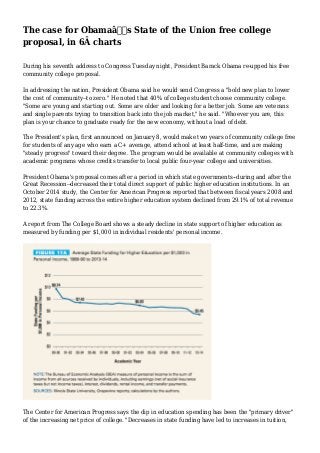The case for Obama’s State of the Union free college proposal, in 6 charts
•
0 likes•454 views
During his seventh address to Congress Tuesday night, President Barack Obama re-upped his free commu...
Report
Share
Report
Share
Download to read offline

Recommended
Recommended
More Related Content
Featured
Featured (20)
Product Design Trends in 2024 | Teenage Engineerings

Product Design Trends in 2024 | Teenage Engineerings
How Race, Age and Gender Shape Attitudes Towards Mental Health

How Race, Age and Gender Shape Attitudes Towards Mental Health
AI Trends in Creative Operations 2024 by Artwork Flow.pdf

AI Trends in Creative Operations 2024 by Artwork Flow.pdf
Content Methodology: A Best Practices Report (Webinar)

Content Methodology: A Best Practices Report (Webinar)
How to Prepare For a Successful Job Search for 2024

How to Prepare For a Successful Job Search for 2024
Social Media Marketing Trends 2024 // The Global Indie Insights

Social Media Marketing Trends 2024 // The Global Indie Insights
Trends In Paid Search: Navigating The Digital Landscape In 2024

Trends In Paid Search: Navigating The Digital Landscape In 2024
5 Public speaking tips from TED - Visualized summary

5 Public speaking tips from TED - Visualized summary
Google's Just Not That Into You: Understanding Core Updates & Search Intent

Google's Just Not That Into You: Understanding Core Updates & Search Intent
The six step guide to practical project management

The six step guide to practical project management
Beginners Guide to TikTok for Search - Rachel Pearson - We are Tilt __ Bright...

Beginners Guide to TikTok for Search - Rachel Pearson - We are Tilt __ Bright...
Unlocking the Power of ChatGPT and AI in Testing - A Real-World Look, present...

Unlocking the Power of ChatGPT and AI in Testing - A Real-World Look, present...
The case for Obama’s State of the Union free college proposal, in 6 charts
- 1. The case for Obama’s State of the Union free college proposal, in 6 charts During his seventh address to Congress Tuesday night, President Barack Obama re-upped his free community college proposal. In addressing the nation, President Obama said he would send Congress a "bold new plan to lower the cost of community--to zero." He noted that 40% of college student choose community college. "Some are young and starting out. Some are older and looking for a better job. Some are veterans and single parents trying to transition back into the job market," he said. "Whoever you are, this plan is your chance to graduate ready for the new economy, without a load of debt. The President's plan, first announced on January 8, would make two years of community college free for students of any age who earn a C+ average, attend school at least half-time, and are making "steady progress" toward their degree. The program would be available at community colleges with academic programs whose credits transfer to local public four-year college and universities. President Obama's proposal comes after a period in which state governments--during and after the Great Recession--decreased their total direct support of public higher education institutions. In an October 2014 study, the Center for American Progress reported that between fiscal years 2008 and 2012, state funding across the entire higher education system declined from 29.1% of total revenue to 22.3%. A report from The College Board shows a steady decline in state support of higher education as measured by funding per $1,000 in individual residents' personal income. The Center for American Progress says the dip in education spending has been the "primary driver" of the increasing net price of college. "Decreases in state funding have led to increases in tuition,
- 2. with families carrying the cost," the Center wrote in its report.
- 3. Likewise, The College Board reports that the inflation-adjusted sticker price of tuition and fees at public two-year community colleges is 2.5 times as much as it was 30 years ago. It should be noted that since 2008-2009 students who attend public two-year colleges have received enough grant aid and tax benefits to cover published tuition and fees, plus a portion of other expenses.
- 4. When grants and aid are accounted for, community college is relatively affordable already. That's one of the major criticisms of Obama's proposal. And while the plan will cover tuition for two years, it won't make a dent in community college students' other expenses, like the nearly $8,000 they must fork over for housing and the $1,700 they pay for transportation. Still, the realignment of revenue from state funding to tuition is still crushing low- and middle- income students. In states with the greatest college funding reductions, students are paying the most at two-year and four-year institutions.
- 5. The Center's study concludes that, in the last decade, states' disinvestment from public education and its subsequent fallout have contributed to a dip in public college attendance among students from low- and middle-class households.
- 6. President Obama's free community college plan aims to address that dip in attendance. If enacted, it will reignite state spending on higher education--federal funds will pay for three-quarters of the average cost of community college but states must cover the rest--with the ultimate goal of making sure that "community college is accessible for everybody." http://rss.cnn.com/~r/fortunefinance/~3/KNfyqFBWsjQ/